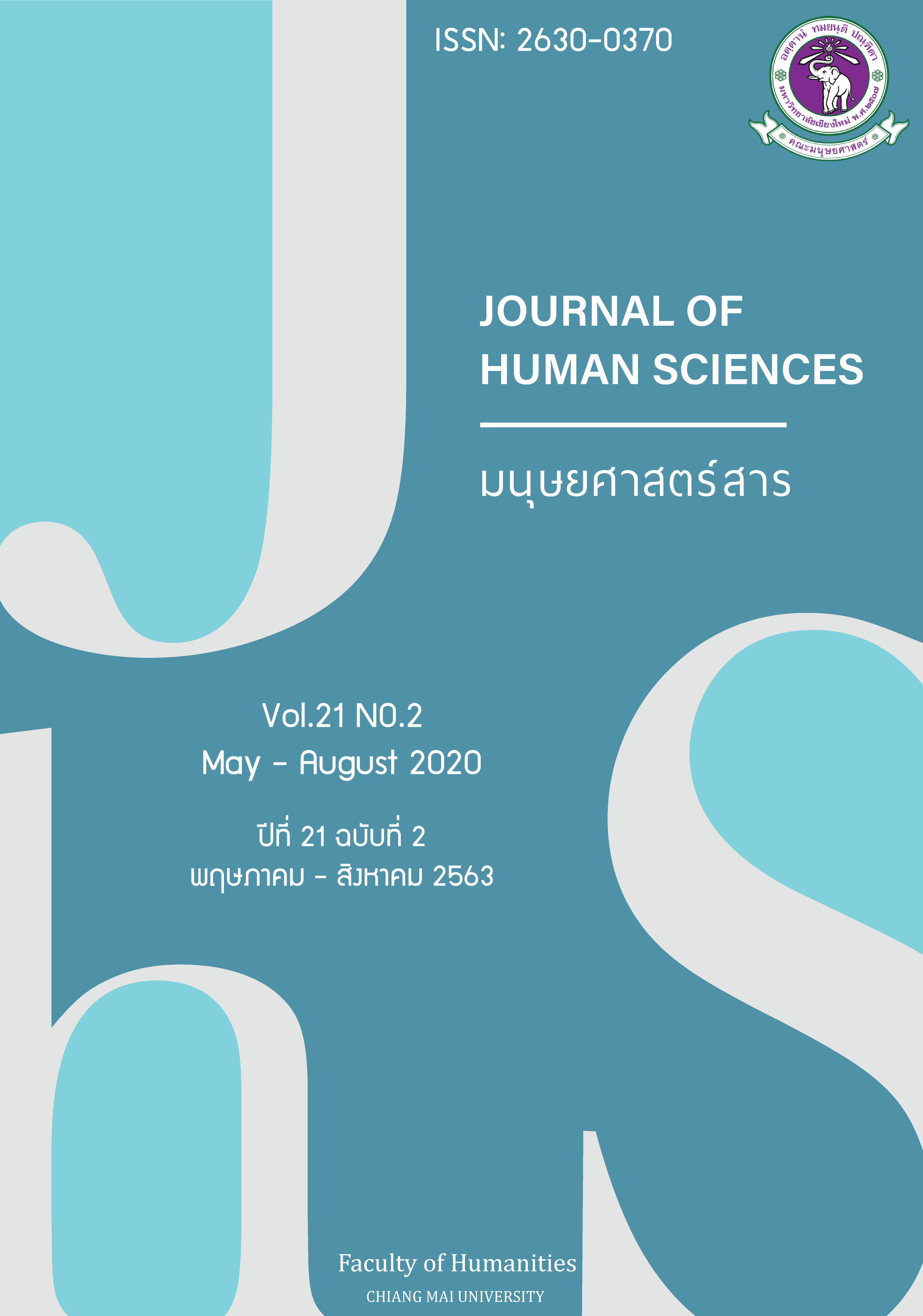การพรรณนากลิ่นช้างในคัมภีร์คชศาสตร์ของปาลกาปยะ
Main Article Content
บทคัดย่อ
กลิ่นปรากฏทั่วไปในวรรณกรรมสันสกฤต โดยเฉพาะกลิ่นดอกไม้ และกลิ่นหอมทั้งหลาย แต่กลิ่นจากสิ่งอื่นปรากฏไม่มากนัก ผู้วิจัยได้ศึกษาการพรรณนากลิ่นของช้างในคัมภีร์คชศาสตร์ของปาลกาปยะ ตำราภาษาสันสกฤตว่าด้วยลักษณะของช้าง โดยมีวัตถุประสงค์เพื่อศึกษาการจำแนกประเภทของกลิ่นช้างในคัมภีร์คชศาสตร์ และเพื่ออธิบายวิธีการพรรณนากลิ่นของช้างในคัมภีร์คชศาสตร์ จากการศึกษาพบว่าคำศัพท์ที่ใช้เรียกกลิ่นในคัมภีร์คชศาสตร์ของปาลกาปยะมีอยู่จำกัด คือคำว่า คนฺธ และสุรภิ กับกริยาจากธาตุ ฆฺรา ที่แปลว่า ดมกลิ่น การจำแนกประเภทกลิ่นของช้างในคัมภีร์คชศาสตร์ของปาลกาปยะนั้นมี 3 เกณฑ์หลักคือ 1) แบ่งตามลักษณะมงคล คือกลิ่นที่มีมงคลและไม่มีมงคล 2) แบ่งตามสัตตวคุณ มีด้วยกัน 6 ชนิด และ 3) แบ่งตามและถิ่นกำเนิดของช้าง มีด้วยกัน 3 กลุ่ม ทั้งนี้ผู้ประพันธ์ได้พรรณนากลิ่นโดยใช้วิธีการเปรียบเทียบ ซึ่งสอดคล้องกับการใช้อลังการชนิดอุปมาในบทกวี โดยมีสองส่วนสำคัญ นั่นคือการเปรียบเทียบ โดยใช้สิ่งที่ต้องการจะกล่าวถึง (กลิ่นช้าง) เรียกว่าอุปเมย การเปรียบเทียบกลิ่นช้างกับสิ่งที่ผู้อ่านคุ้นเคย (พืช สัตว์ และวัตถุสิ่งของ) เรียกว่าอุปมาน เพื่อให้ผู้อ่านเกิดความรู้สึกและมีความเข้าใจชัดเจนถึงกลิ่นเหล่านั้น อุปมานที่ใช้เปรียบกับกลิ่นนั้นแยกได้เป็น 3 ประเภทใหญ่ๆ คือ 1) กลิ่นของสัตว์ 6 ชนิด 2) กลิ่นของพืช 22 ชนิด และ 3) กลิ่นของวัตถุต่างๆ 14 ชนิด อย่างไรก็ตามกลิ่นบางชนิดยังมีคำเรียกมากกว่า 1 คำ โดยรวมจึงมีกลิ่น 42 ชนิด และคำเรียกกลิ่น 48 คำ
Article Details
เอกสารอ้างอิง
Apte, S. V. (1890). The practical Sanskrit-English dictionary. Poona: Shiralkar.
Belgel, R. S., & Belge, A. R. (2012). Critical Study of Gandhashastra with Special Reference to Rasashastra and Bhaishajya Kalpana. IOSR Journal of Pharmacy and Biological Sciences (IOSRJPBS), 2(3). 5-9.
Chatterjee, S., & Datta, D. (1984). An Introduction to Indian Philosophy. Culcutta: Calcutta University.
Chaturvedi, B. J. (2006). Kautilya's Arthshastra. New Delhi: Diamond Books.
Classen, C., Howes, D., & Synnott, A. (1994). Aroma: The Cultural History of Smell. NY: Routledge.
Dave K. N. (2005). Birds In Sanskrit Literature, With 107 Bird Illustrations. (Rev ed.). Delhi: Motilal Banarsidass.
Dixit S. (2007). Ancient India’s Fragrances and its Relevance Today. Chemical Weekly February 27, 209-217.
Dwivedi, D. V. (2014). Asoka (Saraca Indica L.) Plant as Depicted in Sanskrit Literature. International Referred Online Research Journal, (27). 22-43.
Edgerton, F. (2010). The Elephant-Lore of the Hindus. Bangkok: White Lotus.
Hara, M. (2010). A Note On Sanskrit Gandha. Studia Orientalia, 108. 65–86.
Jha, G. (1999). Manusmrti with the ‘Manubhasya’ of Medhatithi, Volume 3. Delhi: Motilal Banarsidass.
Kapoor, K. (1994). Language, Linguistics and Literature: The Indian Perspective. New Delhi: Academic Foundation.
Kooij, K. R. (1972). Worship of the Goddess According to the Kalikapurana. Part I. Leiden: E. J. Brill.
Liu, J., Lu, Y., Wu, Q., Goyer, R. A., & Waalkes, M. P. (2008). Mineral arsenicals in traditional medicines: Orpiment, realgar, and arsenolite. Journal of Pharmacology and Experimental Therapeutics, 326(2). 363-368.
Louriht, N. (2016). Khemi Khong Sanhom. [Fragrance Chemistry]. Bangkok: Chulalongkorn University Press. [In Thai]
McHugh, J. (2013). Sandalwood and Carrion: Smell in Indian Religion and Culture. Oxford: University Press.
Monier-Williams, M. (1899). A Sanskrit-English dictionary etymologically and philologically arranged with special reference to cognate Indo-European languages. Oxford: The Clarendon press.
Narayan, M. K. V. (2007). Flipside of Hindu Symbolism: Sociological and Scientific Linkages in Hinduism. California: Fultus Corporation.
Pabbanchong, W. (2004). Khamphi Yokhasut Khong Patanchali. [Patanjali’s Yogasutra]. n.p.
Payutto, P. A. (2007). Photchananukrom Phutthasat Chabap Pramuan Sap [Dictionary of. Buddhism Vocabulary]. Bangkok: Mahachulalongkornrajavidyalaya University.
Raksamani, K. (2006). Kanwikhro Wannakhadi Thai Tam Thritsadi Wannakhadi Sansakrit [An Approach of Sanskrit Literary Theories to Thai Literature.] Bangkok: Department of Oreintal Languages, Faculty of Archeology, SIlpakorn University.
Rehman, R., Melki, D., Shehzad, A., Nadeem, F., & Khalid, T. (2018). Commercial Importance, Medicinal Value and Therapeutic Potentials of Chaff Flower (Achyranthes aspera)–A Review. International Journal of Chemical and Biochemical Sciences, 14. 62-70.
Royal Institute. (2001). Photchananukrom Sapthoranivitthaya Chabap Ratchabandit tayasathan [Dictionary of Geology, The Royal Institute Edition]. Bangkok: The Royal Institute.
Royal Institute. (2013). Photchananukrom Chabap Ratchabandittayasathan Phoso 2554 (Phim khrang thi song). [Royal Institute Dictionary 2554 B.E. (2nd ed.)]. Bangkok: The Royal Institute.
Sharma P.V. (1998). Ṣoḍaśāṅgahrdayam: Essentials of Ayurveda (2nd ed.). Delhi: Motilal Banarsidass.
Sreeja, K.N. (2016). Dietetics and culinary art in ancient and medieval India - A study with special reference to bhojanakutíhala. (Doctorial’s Thesis. Department of Sanskrit, University of Calicut).
Wakankar, S. Y., & Mhaiskar, V. B. (2006). Maharsi Palakapya’s Gajasastram. Delhi: Bharatiya Kala Prakashan.
Wright P. G., & Luck C. P. (1984). Do elephants need to sweat? South African Journal of Sociology. Dierk, 19. 270-274.


